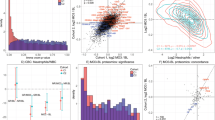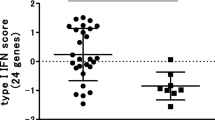Abstract
Applying microarray technology to identify new diagnostic and prognostic markers in peripheral blood cells (PBC) after therapeutic intervention opens great perspectives regarding patient subclassification. Three recombinant products of the pleiotropic agent interferon beta (rIFN-β) are available for disease modifying therapy of relapsing remitting multiple sclerosis (RRMS), a complex inflammatory autoimmune disease that targets the central nervous system. They differ according to formulation, route of administration and dosage regimens. The currently, only partially understood mechanism of action of injected rIFN-β into human organisms needs provision with accessory key molecules; in addition, the significance of established clinical IFN-β response criteria that distinguish responding from non-responding patients remain unclear.
With respect to these major questions, we discuss promising candidates on the gene transcription level, attained from scientific MS literature that included a longitudinal aspect. Reviewed studies were in part carried out with distinct gene interrogating platforms (GeneArrays; RT-PCR), settings (in vitro; ex vivo), and study designs (drug formulations and regimen; inclusion criteria and clinical endpoints), hampering meaningful meta-analysis. Nevertheless, PBC from therapy-naïve MS patients, rIFN-β treated MS patients, and healthy controls served to characterize facets of both the disease and its treatment. Hence, the field of MS transcriptomics in immunomodulatory therapy is (by far) not adequately understood and should be embedded into systems biology disciplines, yielding multi-layer analyses that deliver timely identification of MS subjects who will profit from applied rIFN-β therapy.
Similar content being viewed by others
References
Achiron A, Gurevich M, MagalashviliD, Kishner I, Dolev M, Mandel M(2004) Understanding autoimmunemechanisms in multiple sclerosis usinggene expression microarrays: treatmenteffect and cytokine-related pathways.Clin Dev Immunol 11:299–305
Annibali V, Di Giavanni S, Cannoni S,Giugni E, Bomprezzi R, Mattei C,Elkahloun A, Coccia EM, Alfo M, OrziF, Ristori G, Salvetti M (2007) Geneexpression profiles reveal homeostaticdynamics during interferon-beta therapyin multiple sclerosis. Autoimmunity40:16–22
Baranzini SE, Mousavi P, Rio J, CaillierSJ, Stillman A, Villoslada P, Wyatt MM,Comabella M, Greller LD, Somogyi R,Montalban X, Oksenberg JR (2005)Transcription-based prediction ofresponse to IFNbeta using supervisedcomputational methods. PLoS Biol 3:e2
Baranzini SE (2006) Systems-basedmedicine approaches to understandand treat complex diseases. The exampleof multiple sclerosis. Autoimmunity39:651–662
Bauch A, Superti-Furga G (2006)Charting protein complexes, signalingpathways, and networks in theimmune system. Immunol Rev 210:187–207
Beckmann JS, Estivill X, AntonarakisSE (2007) Copy number variants andgenetic traits: closer to the resolutionof phenotypic to genotypic variability.Nat Rev Genet 8:639–646
Boehm U, Klamp T, Groot M, HowardJC (1997) Cellular responses to interferon-gamma. Annu Rev Immunol15:749–795
Borden EC, Sen GC, Uze G, SilvermanRH, Ransohoff RM, Foster GR, StarkGR (2007) Interferons at age 50: past,current and future impact on biomedicine.Nat Rev Drug Discov 6:975–990
Calvano SE, Xiao WZ, Richards DR,Felciano RM, Baker HV, Cho RJ, ChenRO, Brownstein BH, Cobb JP, TschoekeSK, Miller-Graziano C, Moldawer LL,Mindrinos MN, Davis RW, TompkinsRG, Lowry SF (2005) A network-basedanalysis of systemic inflammation inhumans. Nature 437:1032–1037
Comabella M, Balashov K, Issazadeh S,Smith D, Weiner HL, Khoury SJ (1998)Elevated interleukin-12 in progressivemultiple sclerosis correlates withdisease activity and is normalized bypulse cyclophosphamide therapy.J Clin Invest 102:671–678
Comabella M, Imitola J, Weiner HL,Khoury SJ (2002) Interferon-treatmentalters peripheral blood monocyteschemokine production in MS patients.J Neuroimmunol 126:205–212
Comabella M, Martin R (2007) Genomicsin multiple sclerosis – currentstate and future directions. J Neuroimmunol187:1–8
Der SD, Zhou A, Williams BR, SilvermanRH (1998) Identification of genesdifferentially regulated by interferonalpha, beta, or gamma using oligonucleotidearrays. Proc Natl Acad Sci USA95:15623–15628
de Veer MJ, Holko M, Frevel M, WalkerE, Der S, Paranjape JM, Silverman RH,Williams BR (2001) Functionalclassification of interferon-stimulatedgenes identified using microarrays.J Leukocyte Biol 69:912–920
Efroni S, Harel D, Cohen IR (2003)Toward rigorous comprehension ofbiological complexity: modeling,execution, and visualization of thymicT-cell maturation. Genome Res 13:2485–2497
Eisen MB, Spellman PT, Brown PO,Botstein D (1998) Cluster analysis anddisplay of genome-wide expressionpatterns. Proc Natl Acad Sci USA 95:14863–14868
Fernald GH, Knott S, Pachner A,Caillier SJ, Narayan K, Oksenberg JR,Mousavi P, Baranzini SE (2007)Genome-wide network analysis revealsthe global properties of IFN-betaimmediate transcriptional effects inhumans. J Immunol 178:5076–5085
Floris S, Ruuls SR, Wierinckx A, vander Pol SM, Dopp E, van der Meide PH,Dijkstra CD, De Vries HE (2002) Interferon-directly influences monocyteinfiltration into the central nervoussystem. J Neuroimmunol 127:69–79
Galboiz Y, Shapiro S, Lahat N, Miller A(2002) Modulation of monocytesmatrix metalloproteinase-2, MT1-MMP and TIMP-2 by interferon-gammaand -beta: implications tomultiple sclerosis. J Neuroimmunol131:191–200
GO Consortium (2000) Gene ontology:tool for the unification of biology. NatGenetics 25:25–29
Goertsches R, Hecker M, Koczan D,Thiesen HJ, Zettl UK (2008) Comparisonof 2 year whole genome RNAexpression profiles derived fromperipheral blood reveals evidentpharmacological differences due todistinct Interferon-beta therapies.Neurology 70:A381
Goertsches R, Hecker M, Koczan D,Thiesen HJ, Zettl UK (2008) Time-dependentRNA signatures of peripheralblood cells from Interferon betatreated MS patients disclose consistentdifferential gene expression. Neurology70:A379
Goodin DS, Hurwitz B, Noronha A(2007) Neutralizing antibodies tointerferon beta-1b are not associatedwith disease worsening in multiplesclerosis. J Int Med Res 35:173–187
Hartrich L, Weinstock-Guttman B, HallD, Badgett D, Baier M, Patrick K,Feichter J, Hong J, Ramanathan M(2003) Dynamics of immune celltrafficking in interferon-treated multiplesclerosis patients. J Neuroimmunol139:84–92
Hecker M, Goertsches R, Koczan D,Kekow J, Thiesen HJ, Guthke R (2008)Integrative modeling of gene regulatoryinteractions relevant in antirheumatictherapy. The 9th InternationalConference on Systems Biology(ICSB):A139
Hilpert J, Beekman JM, Schwenke S,Kowal K, Bauer D, Lampe J, SandbrinkR, Heubach JF, Stürzebecher S, ReischlJ (2008) Biological response genesafter single dose administration ofinterferon beta-1b to healthy malevolunteers. J Neuroimmunol 199:115–125
Hoops S, Sahle S, Gauges R, Lee C,Pahle J, Simus N, Singhal M, Xu L,Mendes P, Kummer U (2006) COPASI –a COmplex PAthway SImulator. Bioinformatics22:3067–3074
Hong J, Zang YC, Hutton G, Rivera VM,Zhang JZ (2004) Gene expression profilingof relevant biomarkers for treatmentevaluation in multiple sclerosis.J Neuroimmunol 152:126–139
Hwang D, Rust AG, Ramsey S, Smith JJ,Leslie DM, Weston AD, de Atauri P,Aitchison JD, Hood L, Siegel AF,Bolouri H (2005) A data integrationmethodology for systems biology. ProcNatl Acad Sci USA 102:17296–17301
Iglesias AH, Camelo S, Hwang D,Villanueva R, Stephanopoulos G,Dangond F (2004) Microarray detectionof E2F pathway activation andother targets in multiple sclerosisperipheral blood mononuclear cells.J Neuroimmunol 150:163–177
Kantor AB, Deng J, Waubant E, Lin H,Becker CH, Lacy JR, Perrone AM,Bennett D, Goelz SE (2007) Identificationof short-term pharmacodynamiceffects of interferon-beta-1a in multiplesclerosis subjects with broad-basedphenotypic profiling. J Neuroimmunol188:103–116
Koike F, Satoh J, Miyake S, Yamamoto T,Kawai M, Kikuchi S, Nomura K,Yokoyama K, Ota K, Kanda T, FukazawaT, Yamamura T (2003) Microarrayanalysis identifies interferonbeta-regulated genes in multiple sclerosis.J Neuroimmunol 139:109–118
Lamb J, Crawford ED, Peck D, ModellJW, Blat IC, Wrobel MJ, Lerner J, BrunetJP, Subramanian A, Ross KN, Reich M,Hieronymus H, Wei G, Armstrong SA,Haggarty SJ, Clemons PA, Wei R, CarrSA, Lander ES, Golub TR (2006) TheConnectivity Map: using gene-expressionsignatures to connect small molecules,genes, and disease. Science 313:1929–1935
Limmroth V, Malessa R, Zettl UK,Koehler J, Japp G, Haller P, Elias W,Obhof W, Viehöver A, Meier U, BrosigA, Hasford J, Putzki N, Kalski G,Wernsdörfer C, QUASIMS Study Group(2007) Quality Assessment in MultipleSclerosis Therapy (QUASIMS): a comparisonof interferon beta therapies forrelapsing-remitting multiple sclerosis.J Neurol 254:67–77
O’Doherty C, Villoslada P, VandenbroeckK (2007) Pharmacogenomics ofType I interferon therapy: a survey ofresponse-modifying genes. CytokineGrowth Factor Rev 18:211–222
Oksenberg JR, Baranzini SE, Sawcer S,Hauser SL (2008) The genetics ofmultiple sclerosis: SNPs to pathways topathogenesis. Nat Rev Genet 9:516–526
Palacios R, Goni J, Martinez-Forero I,Iranzo J, Sepulcre J, Melero I, VillosladaP (2007) A network analysis of thehuman T-cell activation gene networkidentifies JAGGED1 as a therapeutictarget for autoimmune diseases. PLoSONE 2:e1222
Pathway Architect 2.0.1 (Iobion; http://www.iobion.com)
Prat E, Martin R (2002) The immunopathogenesisof multiple sclerosis.J Rehabil Res Dev 39:187–199
Quintana FJ, Farez MF, Weiner HL(2008) Systems biology approaches forthe study of multiple sclerosis. J CellMol Med 12:1087–1093
Rani MR, Shrock J, Appachi S, RudickRA, Williams BR, Ransohoff RM (2007)Novel interferon-beta-induced geneexpression in peripheral blood cells.J Leukocyte Biol 82:1353–1360
Reder AT, Velichko S, Yamaguchi KD,Hamamcioglu K, Ku K, Beekman J,Wagner TC, Perez HD, Salamon H,Croze E (2008) IFN-beta1b inducestransient and variable gene expressionin relapsing-remitting multiple sclerosispatients independent of neutralizingantibodies or changes in IFNreceptor RNA expression. J InterferonCytokine Res 28:317–331
Río J, Nos C, Tintoré M, Téllez N, GalánI, Pelayo R, Comabella M, Montalban X(2006) Defining the Response to Interferon-β in Relapsing-Remitting MultipleSclerosis Patients. Ann Neurol 59:344–352
Rudick RA, Lee JC, Simon J, RansohoffRM, Fisher E (2004) Defining InterferonResponse Status in Multiple SclerosisPatients. Ann Neurol 56:548–555
Satoh J, Nakanishi M, Koike F, OnoueH, Aranami T, Yamamoto T, Kawai M,Kikuchi S, Nomura K, Yokoyama K, OtaK, Saito T, Ohta M, Miyake S, Kanda T,Fukazawa T, Yamamura T (2006) T cellgene expression profiling identifiesdistinct subgroups of Japanese multiplesclerosis patients. J Neuroimmunol174:108–118
Satoh J, Nanri Y, Tabunoki H, YamamuraT (2006) Microarray analysisidentifies a set of CXCR3 and CCR2ligand chemokines as early IFNbeta-responsivegenes in peripheral bloodlymphocytes in vitro: an implicationfor IFNbeta-related adverse effects inmultiple sclerosis. BMC Neurol 19:6–18
Shannon P, Markiel A, Ozier O, BaligaNS, Wang JT, Ramage D, Amin N,Schwikowski B, Ideker T (2003)Cytoscape: a software environment forintegrated models of biomolecularinteraction networks. Genome Res13:2498–2504
Sharp FR, Xu H, Lit L, Walker W,Apperson M, Gilbert DL, Glauser TA,Wong B, Hershey A, Liu DZ, Pinter J,Zhan X, Liu X, Ran R (2006) The futureof genomic profiling of neurologicaldiseases using blood. Arch Neurol 63:1529–1536
Singh MK, Scott TF, LaFramboise WA,Hu FZ, Post JC, Ehrlich GD (2007)Gene expression changes in peripheralblood mononuclear cells from multiplesclerosis patients undergoing beta-interferontherapy. J Neurol Sci 258:52–59
Stark GR, Kerr IM, Williams BR, SilvermanRH, Schreiber RD (1998) Howcells respond to interferons. Annu RevBiochem 67:227–264
Steinman L (2001) Gene microarraysand experimental demyelinatingdisease: a tool to enhance serendipity.Brain 124:1897–1899
Sturzebecher S, Wandinger KP, RosenwaldA, Sathyamoorthy M, Tzou A,Mattar P, Frank JA, Staudt L, Martin R,McFarland HF (2003) Expression profilingidentifies responder and nonresponderphenotypes to interferonbetain multiple sclerosis. Brain 126:1419–1429
Tomassini V, Paolillo A, Russo P, GiugniE, Prosperini L, Gasperini C, AntonelliG, Bastianello S, Pozzilli C (2006) Predictorsof long-term clinical responseto interferon beta therapy in relapsingmultiple sclerosis. J Neurol 253:287–293
Tompkins SM, Miller SD (2002) Anarray of possibilities for multiplesclerosis. Nat Med 8:451–453
Wandinger KP, Sturzebecher CS,Bielekova B, Detore G, Rosenwald A,Staudt LM, McFarland HF, Martin R(2001) Complex immunomodulatoryeffects of interferon-beta in multiplesclerosis include the upregulation of Thelper 1-associated marker genes. AnnNeurol 50:349–357
Waubant E, Vukusic S, Gignoux L,Dubief FD, Achiti I, Blanc S, Renoux C,Confavreux C (2003) Clinical characteristicsof responders to interferontherapy for relapsing MS. Neurology61:184–189
Weinstock-Guttman B, Badgett D,Patrick K, Hartrich L, Santos R, Hall D,Baier M, Feichter J, Ramanathan M(2003) Genomic effects of IFN-beta inmultiple sclerosis patients. J Immunol171:2694–2702
Yamaguchi KD, Ruderman DL, CrozeE, Wagner TC, Velichko S, Reder AT,Salamon H (2008) IFN-beta-regulatedgenes show abnormal expression intherapy-naïve relapsing-remitting MSmononuclear cells: gene expressionanalysis employing all reported protein-protein interactions. J Neuroimmunol195:116–120
Author information
Authors and Affiliations
Corresponding authors
Additional information
Conflict of interest The authors have no conflicts of interest to declare.
Role of the funding source No funding sources were involved in the preparation of this article or in the decision to submit it for publication.
Rights and permissions
About this article
Cite this article
Goertsches, R.H., Hecker, M. & Zettl, U.K. Monitoring of multiple sclerosis immunotherapy. J Neurol 255 (Suppl 6), 48–57 (2008). https://doi.org/10.1007/s00415-008-6010-1
Issue Date:
DOI: https://doi.org/10.1007/s00415-008-6010-1




